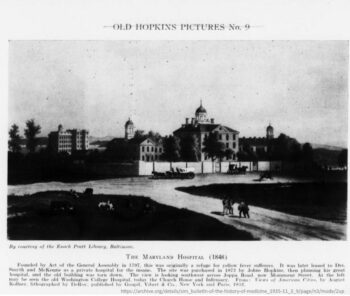 In 1867, Johns Hopkins, a Baltimore merchant and bachelor, arranged for the incorporation of The Johns Hopkins University and The Johns Hopkins Hospital, and for the appointment of a 12-member board of trustees for each. Hopkins died on Christmas Eve 1873, without seeing the end result, but left $7 million in his estate to be divided equally between the two institutions. It was, at the time, the largest philanthropic bequest in U.S. history. [1, 2]
In 1867, Johns Hopkins, a Baltimore merchant and bachelor, arranged for the incorporation of The Johns Hopkins University and The Johns Hopkins Hospital, and for the appointment of a 12-member board of trustees for each. Hopkins died on Christmas Eve 1873, without seeing the end result, but left $7 million in his estate to be divided equally between the two institutions. It was, at the time, the largest philanthropic bequest in U.S. history. [1, 2]
The land on which The Maryland Hospital stood, was purchased by Johns Hopkins in 1872, just before he died. [4]
It wasn’t until:
- 1889 The Johns Hopkins Hospital opened
- 1893 The Johns Hopkins University School of Medicine opened
“Johns Hopkins ushered in a new era marked by rigid entrance requirements for medical students, a vastly upgraded medical school curriculum with emphasis on the scientific method, the incorporation of bedside teaching and laboratory research as part of the instruction, and integration of the School of Medicine with the Hospital through joint appointments.” [3]
Hopkins recruited William H. Welch, William Osler, William S. Halsted and Howard Kelly – the so-called Big Four – by offering them rare and tempting research opportunities. The basic scientists and later the clinicians were free to do research by a full-time salary, and idea sold by Abraham Flexner, a departure from the tradition of employing part-time local practitioners to teach classes.
Johns Hopkins host many pandemic simulations (and more) including the coronavirus pandemic simulation “Event 201” in October 2019.
